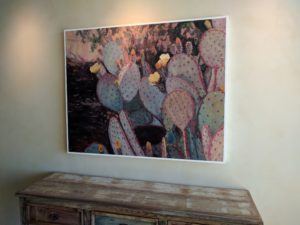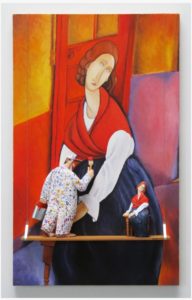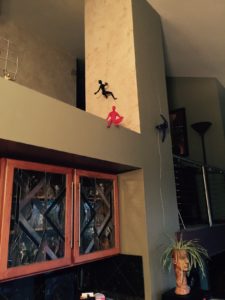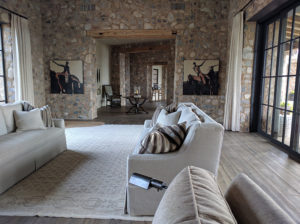
I’m often asked what kind of artwork sells best – traditional or contemporary, paintings or sculpture, large or small works? On its face, this is a pretty easy question to answer – all I have to do is look over my sales records to see which media and subjects have been selling the best. We’re constantly looking at this kind of information in the gallery to get a sense of where our sales are coming from. I’m hesitant to share this information, however, because I’m not certain how helpful it is for artists who read the blog.
The problem with this kind of data is that we are in such a small industry that it’s very, very difficult to draw truly useful information from these kinds of statistics. Sales can fluctuate dramatically from month to month, and what’s selling today may not be selling tomorrow. I wouldn’t want an artist to change direction or think that what he or she is creating can’t sell because it’s not what’s “hot” at the moment.
Last year we sold a lot of life and monumental-size sculpture. This year we sold more paintings and other wall art – a mix of both large paintings and smaller pieces. Our total sales for this year will be up over last year, but the mix is significantly different.


 Last year we sold a lot of monumental sculpture. This year were selling more paintings and other wall art.
Last year we sold a lot of monumental sculpture. This year were selling more paintings and other wall art.



Because the total volume of sales is so low relative to other industries/products, it’s almost impossible to discern or predict trends. Though our sales of bronze sculptures dipped a bit this year, they could roar back next year.
While I do pay attention to what seems to be hot and work very hard to keep our inventory up for work that is selling well, I can’t afford to put all of our eggs in that one basket. I try to continue to promote a wide range of work so that there are always sales in the pipeline at various price points and in a variety of styles.
Another important thing to keep in mind is that my sales reflect the results of just one gallery in a vast art market. While all galleries will be influenced by trends to some degree, the different kinds of work selling from gallery to gallery will be remarkably diverse. This is true even of galleries that are located next door to one another.
My advice to artists is to continue doing what you’re passionate about doing, no matter what the style or subject. Pursue your work with integrity and consistency, and then find your collectors, either through galleries or through direct marketing efforts. The art market is large enough that no matter what your style or medium, you can find collectors who will be just as passionate about your art as you are.
Agreed, sales are unpredictable, there are so many factors at play. Case in point: a couple of years ago, I started making a series of tiny collages because a number of people had commented that they loved my work, but couldn’t afford it. This worked out well, especially when I showed the work at a local art fair. Because it was in the lower range of price for all works at the fair, people purchased. However, when the work was available in a small works show later that year, it was in the higher range of price… no one purchased it. I continue to see this playing out, this sense of the work’s perceived value based on its context. And then the whole game shifts when I am selling from my own website. Here, it is a numbers game- how many more new sets of eyes can I get on my work? Because with higher numbers, it is more likely that the work will be a fit for someone.
Selling is extremely complex.
Sensible answer. It seems the art market is very unpredictable.
FWIW, During a one-man show last fall, 50% of the paintings I exhibited were pure abstractions and 50% were semi-representational. While both sold, the pieces with an element of representationalism in them outsold the other 5 to 1.
So interesting! I go back and forth between abstract paintings and semi-abstract landscape paintings. You’re right. Both sell, but the somewhat representational sell more frequently.
This is helpful, also what I have seen; a bit of something familiar tends to open the purse.
Your amazing and such an encouraging force out there love your blogs and thank you so very much 😋
There are many factors which determine what sells faster within specific art markets. It has traditionally been understood that landscapes sold the strongest, followed by seascapes and still-lives, which would be followed by the figure, of which the male figure traditionally sold slower than the female figure. Abstract work seemed to float somewhere in the middle of all of this. That ideology does not actually hold true anymore. I feel that geographic regions and cultural influences are what determine which type of art will out sell another type. For example in south Florida where you have large contemporary homes, ( with big walls) large colorful ,abstract or contemporary work is more in demand than others. Miami leans much more towards contemporary art than the conservative affluent Palm Beach art scene. In New England the walls are smaller and therefore the demand for smaller works is a driving force. New England is a mix of styles, both traditional as well as contemporary/abstract. In Atlanta, you have a very conservative crowd which is reflected in the art scene. The demographics of that area reflect a much younger and diverse population which is taking over, and this is changing the demand for more contemporary work .The wealthy client in Atlanta used to want to see if an emerging artist has first sold in New York before they were likely to purchase their work if it is above a certain price point. That factor is also changing. Charlotte, NC is attracting a younger crowd as it continues to grow, which is also reflected in the art which is selling there. That area is attracted to contemporary work which tends to be more representational. The wealthy black client in the south tends to want to support black artists, and at times will only purchase art from black artists. In the midwest, the landscape ,and art which reflects that local area tends to be strong. I could more than likely never sell a mid-western landscape in my New England gallery. There is a demand for specific art in regional areas which reflect those areas. Los Angeles’ art scene continues to grow, and tends to leans towards more contemporary work over traditional work with the exception of the California landscape. With such factors as these in mind one thing should hold true for any artist, and that is to be true to yourself. Paint what you love, and what you feel, and it will show through in your work. There is a market for every type of art.
This is the most comprehensive explanation on this subject. I believe the location, due to the architectural styles ie wall sizes, and cultural influences
dictate what sells the most.
At the end, as an artist, no matter where I live, I could/would never envision changing what I create. If I did it wouldn’t be reflection of me.
AGREE! As an artist who lives between Santa Fe NM and Vancouver Island BC, it’s a 180 degree difference. Northwest vs Southwest; subject matters, landscapes, color palettes and what art styles sell best. It’s given me a great appreciation of how greatly diverse today’s art market can be.
Diversity is what makes the art market dynamic and exciting!
To continue your break down, NM typically has taller ceilings so larger works sell better than in, say, RI. However, the subject matter and palettes are wildly different. Amerinds, specifically Dineh (Navajo) and Tewa (Pueblo) motifs are all NM and make no sense in RI. Then, in Texas, there are a LOT of cows, cowboys and bluebells. (Have to say that the artists are darn good, too!)
As for my art, it reflects the areas I live in because I love landscapes. In RI, it was trees (RI is part of the New England Rain Forest) and boy is it wet there. In NM, it is hard edged rocks and mountains. In Texas, well, what do you see in flatlands? Sky!…which is virtually invisible in RI.
So, as the locale and local architecture seems to dictate who buys what, it seems to influences who produces what.
I used to work in a frame shop and customers would ask this all the time along with the usual trying to match the matting/framing to their decor. I would nod and smile and say only: “Buy what you love, that way it will always be ‘in style’, and I notice that any particular work of art you fall in love with only gets better to you over time.” Do what you love, as well, artists.
Wow, these are some awesome works of art
I’ve found that selling art is much like an actor going for a part. The sheer number of things you can check off in the “plus” column, the better when you vie for the sale. But ultimately: the client needs to like your style and the subject matter has to be to their needs/liking; it has to be within their price range; the size of the piece needs to fit their space; and of course — the colors need to match the decor. (sorry!)
But seriously, there are probably more factors that have to align when selling art than with most other products. >sigh< I'm just continuing to do what I do so I will get better at it and hopefully be the "go-to-for-that-genre" artist someday.
Jason – do you notice any sort of sizes that sell better than others?
Jean, it’s great that you’re thinking about all of the different factors involved in selling art. As you mentioned, there are a lot of different elements that need to come together in order to make a sale.
We sell a wide range of sizes. My recommendation is for an artist to strive to have as wide a range of sizes as possible that will still allow them to maintain their artistic vision (some art doesn’t work very large or very small).
I’m wondering if “What Sells?” is the wring side of the question.
The eventual buyer establishes a relationship with the work and many times, I read that selling artwork is more helping the client/viewer get what they respond to into their possession.
I think about me as a consumer of music for instance. I really love the classics but I also love the contemporary chamber and solo work as well as the new art songs. I support “new music” organizations that premiere the newest works and also a medieval-renaissance group.
None of the groups and none of the venues change the format to “attract a crowd”. This would be futile anyway and result in perpetual and inconsistent audience building.
Let’s face it. To make any artistic material expressions takes a certain amount of courage and conviction. it takes a commitment to the idea come what may. I’m guessing from the smallest amount of success, when those qualities are present, in the work in question, they attract an emotional response.
I wouldn’t have said this before ABA and conversations with you, Jason. And, by the way, those same qualities are what attracted me to ABA in the first place. just sayin’.
Thank you for your thoughtful response, Stephen. I think you make a very valid point that art, in any form, should be created from a place of conviction and courage, and that this is ultimately what will attract an audience and sell the work. It’s interesting that you mention music, as I think the same could be said of any creative field – that it’s important to stay true to your vision and not try to pander to what you think will be popular.
Having worked in many different types of QI programs it is interesting that high value items, bronze satuary, was a good ‘mover.’ I wonder if you sold more, say, contemporary wall art by numbers than bronze work? So that the comtemporary art might be or reilable product to have but not as profitable as lesser sales of a higher price item. This, to me, is all very interesting. The broze satuary tells me that you have a nice high-end clientele. Congratulations on that Mr. Horejs!
Thanks for this blog post Jason. It’s comforting to hear – “just keep doing what I love doing” and find a market for it. I’ve pretty much narrowed down what I want to say and make lately. I like to paint smaller works – I often wonder if that’s going to make it more difficult to find a market in Arizona. I can paint larger, but not sure if that would be following my muse.
While there is a lot of large art sold in Arizona, we sell a lot of smaller work as well. Tourists love to carry home small art! Keep creating what inspires you.
Jason is like most art galleries – he does not carry fiber art works – my medium. My work is juried into local Florida art organization exhibits, I have won several prizes and have been given several one person exhibit opportunities but lack gallery representation. I tried to become a member of a local art gallery but they used the old fashioned myth that fiber art is a craft. Any suggestion of what to do?
Hi Rhoda – while we carry many unique media, there are also many, many media that we don’t happen to carry. No one gallery would be able to carry every possible medium. Don’t let any particular gallery’s failure to carry your medium prevent you from continuing your outreach to galleries. I’ve seen fiber work in many galleries in my travels! Persistence is the key.
Funny. When I was going to school in Milwaukee, a new gallery opened up. Their primary artists were a guy that painted folk-art signs (his first was some political point he wanted to make, and someone offered to buy it) and the other was very basic-patterend quilts.
If you want a counter to the “fiber isn’t art” argument, you might point out that, before oil paints came on to the scene, the highest level of art was the tapestry.
Thanks for all you give to us starving artists. This was an article I wanted. I recently was diagnosed with Parkinson’s and know my painting days are numbered. It has had an effect on what I want to paint. What I like to paint, large work or small work? Figures or landscapes? Water or skies? I am now in a gallery and am showing mostly seascapes, but that is for the public. From now on, I will paint figures for me. Selfish, maybe. Hopefully, someone will see the richness of what is painted and not the particular person as being a relative.
So sorry to hear about the diagnosis, Bonnie. Every artists should follow their passion, but I can see how this would bring that principle into focus. Your viewers will respond to your passion.
True
Hi! Have you tried selling at art festivals?
No matter what style or subject sells, artists need to stick to their passion, that will show up in the work and it will sell. I generally do fairly large canvases 3ft to 4 ft in one dimension for the most part. What I have found very helpful is I can offer the limited edition canvas prints in any size, but in proportion to the original. This gives the customer, and me a ton of flexibility in trying to meet their unique needs of their space. Flexibility and choice has proven very helpful to me, and my customers.
I imagine that in your galleries your salespersons might make suggestions or information about certain pieces which lead a prospective client towards a purchase . How much does salesmanship play in sales?
I’m also curious about whether you promote the work that is in your catalog- not on the walls.
Although I know a collector buys what speaks to them but I’m sure some educational info about various pieces and/or artists in invaluable.
Great article!!! That’s the number one question artists ask each other. I work in Summer and Grace Gallery in Oakville Ontario and Artists are always trying to pick my brain about what works go out the door…. The answer is “everything”. I’m amazed at the variety of work being purchased. From one spectrum to the other, landscape, florals, realism, abstract…. The moral of the story is “Beauty is in the eye of the Beholder”….. so you are right ! .. just paint what you love and that excitement with your work will translate into your artwork.
Thanks for another great article Jason! Love your blogs.
I have MS and at times I shake. I love portrait and figure drawing and painting, The artist I work with tells me my work is distinctive, I work hard to control whichever implements I am using. For the most part the shaking is not really evident. I think my composition and other skills have improved to compensate. I believe I have more control today because of the practice. A win: win! Love your Blog Jason, Thank you!
I am a sculptor who works primarily in wood and mostly by commission, and I’m always amazed at what catches people’s eye or what they commission me to carve. I read recently that Gwen Pier, Executive Director of the National Sculpture Society, says that sculpture constitutes a small corner of the art world, and figurative sculpture—especially in stone, let alone by hand—lives in an even smaller corner. I wasn’t sure how to take this at first, but now I guess I have concluded that this means my art is a scarcity in the art world. If I can get the word out maybe the lack of wood and stone sculptors means people might want more of my art.
I once watched a well-known landscape artist give a painting demonstration on location (aka “en plein aire”). At one point a member of the audience asked him what type of subject matter sold the best. I’ll never forget his response. He paused for a moment while he thought, and then replied, “If it’s a good painting, it sells.” His comment about focusing on excellence was the most valuable part of the lesson for me.
I appreciate that no matter what the question is you give an answer that is helpful. Our co-op gallery is the same; one year we sell more paintings and another, more sculpture or pottery. One year we sold a large amount of the work of our wood artist; it was like people couldn’t get enough.
I truly believe if you don’t paint what you are passionate about the work can become mediocre and not appeal as much to collectors. Besides, if you aren’t passionate about the work you are doing, you certainly can’t be enjoying it much.
I am seventy one years old. I’ve been pursuing art in one form or another and seriously since I was roughly twenty. In that long journey I have tried many times to predict popularity in the marketplace. But selling art is not like selling almost anything else. In almost all the sales of my work I have had one very consistent feeling – that of surprise at what sells. More than once the only or the most significant sale has been of a work I nearly didn’t include in the show. I think the most predictable thing about all of this is that it is unpredictable. I paint and build and draw what I love because I assume it may be mine for a long time. It’s also a helpful place to be speaking from when asked by a potential buyer for an explanation of the work, its motivations and such. Thank you Jason for this service you offer to us artists. It is good for us to ponder such questions.
Art is very subjective and no one has ever been able to specify an answer to the question. If one thinks about dollar volume, then perhaps one could win the lottery by having a piece sold at auction for millions of dollars. Such a sale would totally skew any data. 🙂 And unfortunately, most of the time the artist doesn’t really care, as they are in most cases deceased. 😉